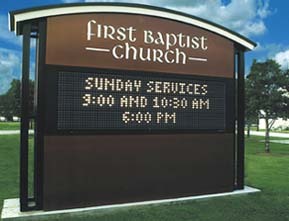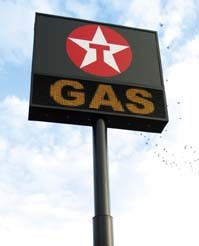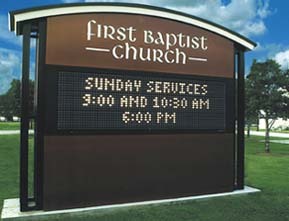Electric Signs
Talkin’ about an Evolution
Alternative display media and their relative merits
Published
18 years agoon

In March’s "The Moving Message" column, I advocated the study of advertising as a groundwork for electronic-sign sales. I even went so far as to advise you to "ignore the technology; learn about advertising first." Obviously, that advice comes with a caveat: Once you have a fundamentally sound understanding of advertising and electronic signs’ relative value as a medium, it is then time to talk about technologies. The technology evolution The electronic sign industry is just a few months shy of its 50th anniversary. Throughout most of that history, the technology was dominated by incandescent lamps, which are big, change slowly and are short-lived. Consequently, the medium was limited to low-resolution text messaging. Approximately 20 years ago, Brent Brown of Integrated Systems Engineering (Logan, UT), advanced the truly revolutionary concept of smaller, wedge-base lamps, which lasted longer and changed more quickly. The wedge-base revolution was catalyzed by PC-based control systems’ extra memory and processing speed. Thus, higher resolution signs could be configured into full-matrix displays, which commingled pictures, animation and text messages. As the PC advanced, so did sign-control capacity and processing speed. Soon, PCs powered commercially affordable, color-lamp systems, utilizing white, wedge-base lamps with plastic filters. In the early ’80s, as higher energy costs first raised their ugly heads, alternative display media surfaced — the flip disc, the liquid crystal display (LCD) and the light-emitting diode (LED). Initially the most prominent alternative to lamps, the flip-disc display was limited by mechanical failures, lack of brightness and slow change speed. It soon became all but extinct. To my knowledge, only 3M (formerly American Electronic Sign Co.), St. Paul, MN, still produces a commercially available product. LCD displays lived a very short, litigation-stained timespan. Originally offered as a viable alternative to lamps in sunlight, the technology delaminated, leaked and faded. The LED was originally limited by the availability of only three colors (none of them white), an unacceptable angle of visibility and low brightness level. The outdoor, electronic-sign industry in the ’80s looked at the LED and said, "Next." Fortunately, a few visionaries pushed the product’s evolution and eventually dragged the rest of us into the pool. Fifteen years ago, I remember George Sugarman of MultiMedia Electronic Displays (Rancho Cordova, CA) standing in a tradeshow booth in front of a blood-red, outdoor LED sign, sneering at the incandescent sign salespeople as they raked in bigger customers. He ranted at us about the LED’s lifespan and its evolution, proclaiming that we would all join him in the future. He was right.MultiMedia Electronic Displays Now the pre-eminent technology in the industry, the once foreign little diode comes in a wide array of colors, sizes, shapes, brightness levels and viewing angles. Powered with computers and video-processing systems, LEDs offer almost unlimited types of messaging. The technology today Virtually all the technologies I’ve mentioned are still sold today, with the notable exception of the LCD sign. While I most frequently tout LEDs’ relative merits, other products still hold important niche positions in the electronic-message field and are best suited for certain applications. I’ve briefly assessed various product types, their most frequent markets and most prominent manufacturers. Large-lamp displays. In today’s vernacular, these signs are known as "freeway blasters." The behemoths are designed to reach high-speed freeway traffic with enough viewing distance and punch to throw a driver onto an exit ramp with an immediate purchase in mind — raw, base-level marketing in its purest form. Some of the oldest manufacturers in the industry still lead this market segment. Time-O-Matic Inc. (Watchfire Signs) (Danville, IL) and |2126| (EDS), Grand Island, NE, probably share 75% of the market.Time-O-Matic Inc. (Watchfire Signs), Electronic Display Systems Flip-disc technologies. 3M Dynamic Message Systems (St. Paul, MN) offers an extremely low-energy, text-message display system that utilizes smaller, fairly dependable discs. Because some sign ordinances still prohibit moving or changing light signs in any format, 3M’s disc signs offer an exception to such provisions. Likewise, some businesses, including churches and some specialty retailers, prefer the less intrusive format to the "freeway blasters." Wedge-base lamps. The only drawbacks to wedge-base display systems are energy consumption and their 15,000- to 20,000-hour life. The product is particularly suitable for applications not subjected to around-the-clock usage. Consider a scoreboard’s text applications. Why would a team pay the extra dollars for LEDs’ long life when messages are shown for only 100 hours per year? Because LED signs cost more than wedge-base lamps, many customers opt for the cheaper technology. Wedge-base still offers a workable scenario, particularly for a retail establishment with limited hours of high traffic. Wedge-base displays are available from many quality suppliers, including Daktronics Inc. (Brookings, SD), Time-O-Matic, Visiontech Electronic Message Displays (Springfield, MO), EDS and Young Electric Sign Co. (YESCO), Salt Lake City. Suppliers in the midst of re-orienting their focus to LEDs can offer great bargains.Daktronics Inc., VISIONTECH Electronic Message Displays LED text-message displays. LED displays first appeared indoors as single lines of text messaging, typically comprising 2- to 4-in. characters, in banks, supermarkets, convenience stores and other applications. As the diode technology grew, so did the displays’ size and ambient light applications. Today, outdoor LED text displays are available in character sizes ranging from 6 in. to 6 ft. LEDs configured into large pixels emulate the size and shape of a large lamp. Displays are available in red, amber, green and white. Because of LEDs’ long life, low energy cost and low maintenance requirements, many new signage applications have taken root. Chain retail and fast-food establishments, which previously hadn’t utilized electronic-displays, are now legitimate users. McDonald’s has incorporated both red and amber displays in a number of markets. Walgreens is deploying red LED marquees in many municipalities. Petroleum companies are experimenting with LED "price-changer" systems. In smaller, 14- to 21-in. text sizes, ranging from various companies, such as Daktronics, Visiontech, Time-O-Matic, EDS, YESCO and MultiMedia, offer LED, cluster-pixel technologies. In larger character sizes, YESCO has created clusters that reach freeway traffic without blasters’ electricity and maintenance costs. While blasters provide more visual punch than subtler LEDs, LEDs, in turn, furnish financial savings, greater viewing distance and a quicker change. Also, lamps halo badly from a distance, particularly at night. This problem is exacerbated by the slow rate of change as filaments charge and uncharge. LED clusters can operate at a much lower brightness level at night, while simultaneously charging and discharging almost instantly. LED color video/slide-show displays. Full-color LEDs’ wide array of pixel pitches, brightness levels and viewing angles have enabled this technology to present an outdoor, photo-quality image, either fixed or moving, in sizes ranging from 50 to 10,000 sq. ft. The number of full-color LED suppliers in the world today is estimated to be approximately 85, at least 20 of which currently market in the United States. Among the most prominent full-color LED suppliers operating in America are Daktronics, MultiMedia, Lighthouse Technologies (Raleigh, NC), YESCO, Mitsubishi Electronics America Inc. (Norcross, GA) and Barco (Kortrijk, Belgium). The dangerous aspect of reselling in this industry is its newness; the players can change quickly, as evidenced by the fact that four of Y2K’s top U.S. suppliers no longer operate (SACO, Sony, Ad-Art and Display Ad). The most expensive display systems are also the most complicated to program. Consequently, they can be the most dangerous sale you can make, unless you have undergone extensive training. So, choose your supplier carefully. Ask many questions, gather support and study the supplier’s relative condition as a viable provider of parts and services in the future.

SPONSORED VIDEO
Introducing the Sign Industry Podcast
The Sign Industry Podcast is a platform for every sign person out there — from the old-timers who bent neon and hand-lettered boats to those venturing into new technologies — we want to get their stories out for everyone to hear. Come join us and listen to stories, learn tricks or techniques, and get insights of what’s to come. We are the world’s second oldest profession. The folks who started the world’s oldest profession needed a sign.
You may like

NUtec Digital Ink Invests in Solar Energy for Facility

5 Reasons to Sell a Sign Company Plus 6 Options

21 Larry Albright Plasma Globes, Crackle Tubes and More
Subscribe

Bulletins
Get the most important news and business ideas from Signs of the Times magazine's news bulletin.
Most Popular
-

 Photo Gallery4 days ago
Photo Gallery4 days ago30 Snapshots of the 2024 ISA Sign Expo
-

 Tip Sheet2 weeks ago
Tip Sheet2 weeks agoAlways Brand Yourself and Wear Fewer Hats — Two of April’s Sign Tips
-

 Ask Signs of the Times6 days ago
Ask Signs of the Times6 days agoWhy Are Signs from Canva so Overloaded and Similar?
-

 Paula Fargo1 day ago
Paula Fargo1 day ago5 Reasons to Sell a Sign Company Plus 6 Options
-

 Real Deal2 weeks ago
Real Deal2 weeks agoA Woman Sign Company Owner Confronts a Sexist Wholesaler
-

 Benchmarks1 week ago
Benchmarks1 week ago6 Sports Venue Signs Deserving a Standing Ovation
-

 Photo Gallery1 day ago
Photo Gallery1 day ago21 Larry Albright Plasma Globes, Crackle Tubes and More
-

 Women in Signs2 weeks ago
Women in Signs2 weeks ago2024 Women in Signs: Megan Bradley












